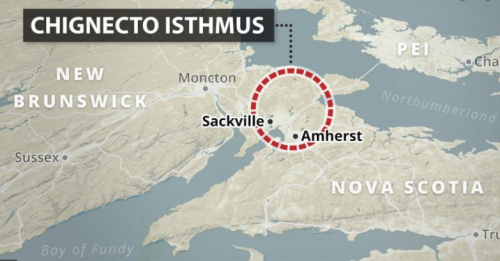NS and NB Prime Ministers, Federal Minister Meets Monday to Discuss Chignecto Isthmus Project Funding
The question of who will pay to protect the fragile highway and rail infrastructure along the Isthmus of Chignecto corridor connecting mainland Nova Scotia and New Brunswick will be the focus of a Monday meeting in Moncton.
“This is an important issue and we need to move forward on this for so many reasons,” Nova Scotia Prime Minister Tim Houston said in a press briefing Thursday.
“It’s a federal responsibility, it’s disappointing that so far they’ve taken the position that it’s not the case,” Houston said during Monday’s meeting he has with New Brunswick Premier Blaine Higgs and Dominic LeBlanc, the federal infrastructure minister. and communities.
In March 2022, a $700,000 engineering study emerged with the three best options for protecting highway and rail infrastructure, including bridges, along the 14-mile (23-kilometer) strip of land.
The first of the three was to raise existing levees to 10.6 meters, levees that hold back Bay of Fundy waters that threaten the corridor infrastructure that supports about $35 billion in annual trade.
The second option was to build new dikes up to 10.6 meters and the third was to raise the existing dikes and install steel sheet piles in selected and vulnerable locations. The estimated cost of the infrastructure upgrade, originally pegged at $189 million to $300 million, is now estimated to be somewhere between $400 million.

The two provinces had to choose a preferred option, and a spokesman for the Nova Scotia Public Works Department said Nova Scotia and New Brunswick chose a hybrid version of the first two options presented.
“The Chignecto Isthmus is a vital supply link between Nova Scotia and New Brunswick,” Jean-Sebastien Comeau, a spokesman for Dominic LeBlanc’s office, said in an email last month.
“Secretary LeBlanc recognized its importance and wrote to his counterparts in Nova Scotia and New Brunswick urging them to apply for funding under the Disaster Mitigation and Adaptation Fund.”
In his June 23 letter to the Prime Ministers, LeBlanc wrote that he wanted to reiterate “that the federal government is not responsible for a full funding” of the project.
“As stated in my letter dated April 26, 2023, both the Parliament of Canada and the provincial legislative assemblies have exclusive authority over how their funds are appropriated and spent.”
LeBlanc’s letter stated that the counties could apply for up to half the cost of the project through the federal disaster relief fund.
A spokesman in LeBlanc’s office said Friday that the federal commitment through disaster funding has not changed. However, Wednesday, two days after the Moncton meeting, is the last day for acceptance of disaster relief funding applications and the spokesperson said the positive outcome of that meeting would be New Brunswick and Nova Scotia agreeing to apply in the appropriate form that would allow the federal government to finance half the cost of the project.
“I’m hopeful that Monday’s meeting will be productive,” said Houston. “The (project) work will be done, but we will work with the federal government on how that will be paid for. If we have to take them to court, that would be very disappointing.”
Houston said he is prepared for the outcome of Monday’s meeting.
“The work has been done on the (disaster funding) application, but filing that application is not a good outcome for Nova Scotians,” Houston said.
The Prime Minister said that it was discussed with the other Prime Ministers at this week’s Federation Council that the Federal Government, with its position on the financing of Isthmus infrastructure, has expressed its view on the federal responsibility to maintain all nationally important infrastructure.
Houston said if the federal government forces Nova Scotia and New Brunwwick to go to court to try to recover money the counties have to pay as they apply for funds under the existing program, “that’s money that can’t be used for a whole host of other projects that are important.”
He said he is hopeful that the prime ministers and the federal minister can have a mature discussion on Monday.
“Apart from the threat of legal action that Prime Minister Houston and Prime Minister Higgs have put on the table, it would be great if we could go on a sidetrack, a different track to get the project going, because ultimately it’s the communities along the isthmus that will benefit,” said the source in LeBlanc’s office. “We can resolve any legal questions along the way.”
Houston has likened the infrastructure project to the Confederation Bridge that connects PEI to New Brunswick and was built with federal funds, but the federal minister’s spokesperson said, “We are convinced that no comparison can be made between an article by Confederation and the Chignecto Isthmus in terms of the federal government’s responsibilities, but other than that, let’s put that (funding) application in.






